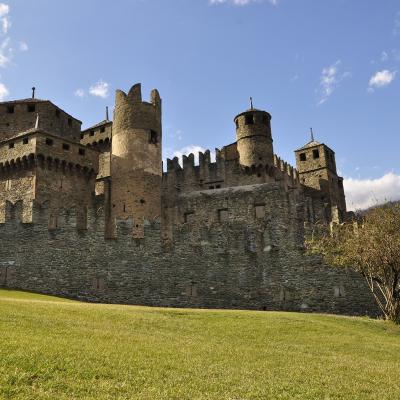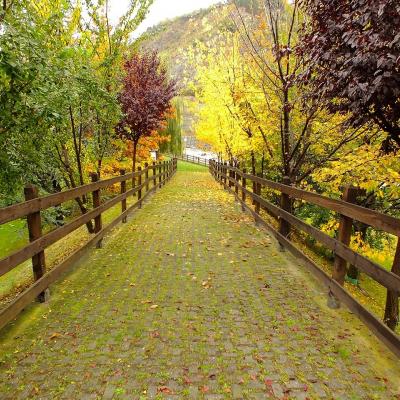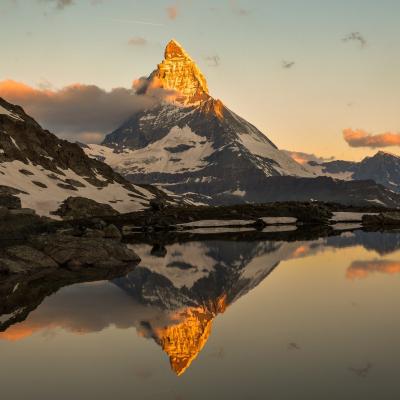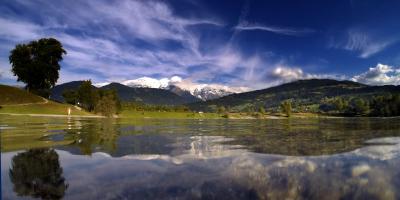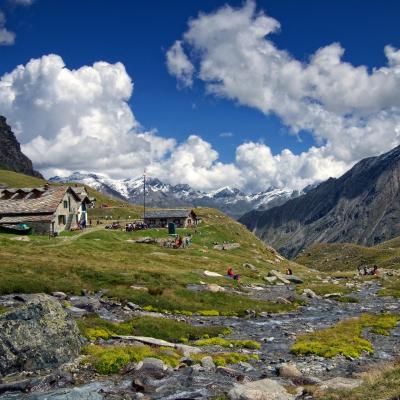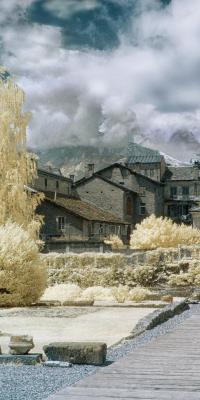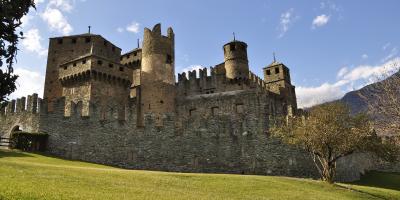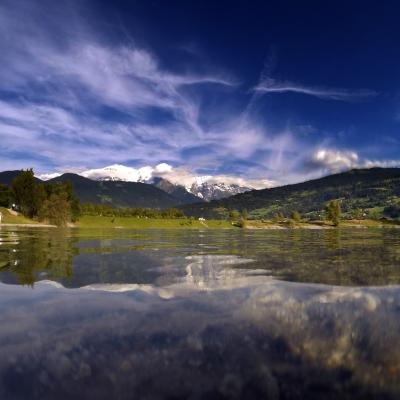Aosta Valley
Set between the Graian and Pennine Alps, the Aosta Valley is surrounded by the highest mountains in Europe, culminating in the massifs of Monte Bianco (4807 m), the Monte Rosa (4634 m) and the Gran Paradiso (4061 m). Other notable peaks located on the region's borders are the Matterhorn (4478 m), Dent d'Hérens (4171 m), Mount Vélan (3708 m), in the Grand Combin massif, the Rutor, of more modest height (3486 m) but covered by a vast glacier, Grande Sassière (3751 m); while in the interior a number of very high rocky pyramids rise isolated, such as Becca di Luseney (3504 m), Emilius (3559 m), which dominates Aosta, Tersiva Peak (3513 m) and, highest of all, La Grivola (3969 m).
The entire region is drained by the Dora Baltea, whose valley originates below Mont Blanc from the confluence of the Veny and Ferret valleys and forms the central axis of communications and settlements; into it flow in a comb-like fashion the lateral valleys, which are (to limit themselves to those permanently inhabited) on the right the La Thuile valley, the Valgrisenche valley, the Rhêmes valley, the Valsavarenche valley, the Cogne valley and the Champorcher valley; on the left, the Great St. Bernard valley, Valpelline (into which the Ollomont valley flows), the more modest Saint-Barthélemy valley, Valtournenche, Val d'Ayas, and Gressoney valley. The streams in these valleys are rich in water, thanks to abundant nival and glacial supply; maximum flows occur from May to July, due to snowmelt, minimums in winter, when snowmelt is limited to the few hours of sunshine. No lakes of any consistency are found in the Aosta Valley, but only small alpine lakes (albeit very picturesque) and reservoirs.
Culture, in the Aosta Valley, flows through a past as a place of transit and exchange not only of goods, but also of ideas and thoughts, and through the need to keep alive contacts with the many neighboring realities. In this context, the Centre d'études franco-provençales "Renée Willien" in Saint-Nicolas stands out above all, protecting mountain culture with particular regard to the patois, the language still spoken by many Valle d'Aosta people. But each area of the region has been able to build significant ties with neighboring lands; thus the Champorcher, Cogne and Savarenche valleys are knotted with the Piedmontese valleys of the upper Canavese; the Gressoney and d'Ayas valleys still converse with the Swiss resorts of Zermatt and Saas Fee; the Valgrisenche and Little St. Bernard valleys are in close contact with the French Tarantaise; the Great St. Bernard valley helps bring Aosta closer to Martigny, both important centers for thematic exhibitions. A frontier land, then, that has been able to draw its cultural richness from this, presenting itself, however, dotted with a multitude of castles erected in strategic positions, often perched on rocky spurs, guarding the valleys. And guarding the traditions that are deeply rooted here and closely linked to the mountain world, to respect for nature and its rhythms.
Must-see
La Thuile: The center has now established itself as a summer resort and winter sports resort thanks to an international ski area (with a single ski pass, it is possible to reach the French resort of La Rosière, just over the Petit St. Bernard Pass, which has 65 slopes for a total of 150 km of downhill runs). Heliskiing is also possible on the Mount Rutor glacier. Industry operates in the construction and mechanical sectors.
Gran Paradiso National Park: created as a result of the donation made to the Italian state by King Victor Emmanuel II of a territory of more than 2,000 ha, it is the first national park established in Italy; the area, however, was already under protection since 1856 as a Royal Hunting Reserve to protect the ibex, which is close to extinction. The park safeguards almost in its entirety the Gran Paradiso group in the Graian Alps, the only peak above 4,000 m totally on Italian territory, crowned by spectacular peaks and glaciers. It is bounded by the valleys of Rhêmes to the W and Cogne to the N, between which Valsavarenche is wedged, the Soana valley to the E, and the Orco valley (Locana valley) to the S, and borders the French Vanoise National Park. The park's environment is predominantly alpine, rich in streams, lakes and waterfalls, and a cultural heritage--represented by villages and mountain pastures, numerous stone (Piedmont side) and stone and wood (Aosta side) dwellings, and also the iron mines of the Cogne valley, exploited for centuries and remaining active until the late 1970s--whose protection and enhancement, together with the promotion of economic development in harmony with environmental needs, are the objectives pursued by the Park Authority.
At the foot of Mont Blanc stands the establishment of Pré Saint Didier,the pearl of the Aosta Valley and of a spa wellness discovered by the ancient Romans and appreciated by the royal family of Savoy as early as 1800. The unmistakable profile of the Alpine range has always instilled unparalleled strength and tranquility, embracing both the historic building of the Pré spa.
Enogastronomy
The cuisine of Valle d'Aosta is affected by the influences of the various peoples who have inhabited the area over the centuries and is characterized by a variety of dishes related to the typical mountain essence of the region. This is why many specialties derive from the widespread dairy activity. Particularly well known is souppe alla valpellineintze (bread, cabbage, fontina cheese and broth), originating, as its name implies, in Valpelline, prepared in a myriad of different versions in other towns in the region as well. Also made with cheese are gnocchi alla bava, Aosta Valley-style ribs and, of course, the well-known fondue. Also excellent and numerous are the dishes in which game is the protagonist, such as venison alla valdostana, roast marmot or in civet. Delicious cured meats include mocetta (chamois meat, either beef or venison, dried and flavored with garlic, sage, and rosemary) andArnad lard, made only from selected local pigs and cured in glass or terracotta containers.
Of exceptional quality is also the jambon de Bosses, whose particularity derives from the cold but temperate microclimate with low rainfall typical of Saint-Rhémy-en-Bosses. Valle d'Aosta desserts include tegole (thin, round-shaped almond pastries) and blanc manger. In terms of oenology, the region holds the enviable record of the highest vineyards in Europe: those of Morgex and La Salle (1,200 m), which yield fragrant whites. Among the AOC reds, Donnas and Enfer d'Arvier are famous. There is also widespread production of fortified wines in the region, such as moscato di Chambave, malvasia di Nus and montouvert. An excellent grappa is also made, as well as a well-known liqueur made from alpine herbs: genepi. Regional products with a PDO mark are fromadzo, fontina cheese and the aforementioned jambon de Bosses and Arnad lard.
